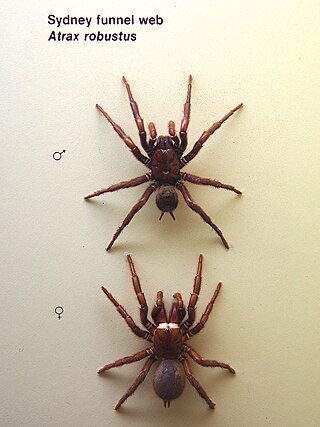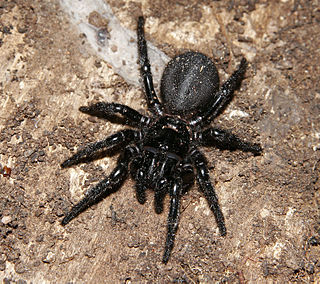
The Mygalomorphae, or mygalomorphs, are an infraorder of spiders, and comprise one of three major groups of living spiders with over 3,000 species, found on all continents except Antarctica. Many members are known as trapdoor spiders due to their creation of trapdoors over their burrows. Other prominent groups include Australian funnel web spiders and tarantulas, with the latter accounting for around one third of all mygalomorphs.

The family Dipluridae, known as curtain-web spiders are a group of spiders in the infraorder Mygalomorphae, that have two pairs of booklungs, and chelicerae (fangs) that move up and down in a stabbing motion. A number of genera, including that of the Sydney funnel-web spider (Atrax), used to be classified in this family but have now been moved to Atracidae.

Atracidae is a family of mygalomorph spiders, commonly known as Australian funnel-web spiders or atracids. It has been included as a subfamily of the Hexathelidae, but is now recognised as a separate family. All members of the family are native to Australia. Atracidae consists of three genera: Atrax, Hadronyche, and Illawarra, comprising 35 species. Some members of the family produce venom that is dangerous to humans, and bites by spiders of six of the species have caused severe injuries to victims. The bites of the Sydney funnel-web spider and northern tree-dwelling funnel-web spider are potentially deadly, but no fatalities have occurred since the introduction of modern first-aid techniques and antivenom.

The Araneomorphae are an infraorder of spiders. They are distinguishable by chelicerae (fangs) that point diagonally forward and cross in a pinching action, in contrast to the Mygalomorphae, where they point straight down. Araneomorphs comprise the vast majority of living spiders.

Theridiidae, also known as the tangle-web spiders, cobweb spiders and comb-footed spiders, is a large family of araneomorph spiders first described by Carl Jakob Sundevall in 1833. This diverse, globally distributed family includes over 3,000 species in 124 genera, and is the most common arthropod found in human dwellings throughout the world.

Hexathelidae is a family of mygalomorph spiders. It is one of a number of families and genera of spiders known as tunnelweb or funnel-web spiders. In 2018, the family was substantially reduced in size by genera being moved to three separate families: Atracidae, Macrothelidae and Porrhothelidae.

Hadronyche formidabilis, the northern tree-dwelling funnel-web spider, is a medically significant mygalomorph spider found in Queensland and New South Wales. It is also known as the Northern Rivers funnel-web spider or northern funnel-web spider.

The Sydney funnel-web spider is a species of venomous mygalomorph spider native to eastern Australia, usually found within a 100 km (62 mi) radius of Sydney. It is a member of a group of spiders known as Australian funnel-web spiders. Its bite is capable of causing serious illness or death in humans if left untreated.

Atrax is a genus of venomous Australian funnel web spiders that was first described by O. Pickard-Cambridge in 1877 from the type species Atrax robustus. As of May 2019 it contains only three species: A. robustus, A. sutherlandi, and A. yorkmainorum. Originally placed with the curtain web spiders, it was moved to the Hexathelidae in 1980, then to the Australian funnel-web spiders in 2018.

Delta atracotoxin is a low-molecular-weight neurotoxic polypeptide found in the venom of the Sydney funnel-web spider.

Missulena bradleyi, also known as the eastern mouse spider, is a species of spider belonging to the family Actinopodidae. The spider is endemic to the eastern coast of Australia.

Hadronyche infensa, the Darling Downs funnel-web spider, is a venomous mygalomorph spider, one of a number of Australian funnel-web spiders found in Queensland and New South Wales.

Hadronyche cerberea, the southern tree-dwelling funnel-web spider, is a venomous mygalomorph spider found in central New South Wales, Australia.

Hadronyche versuta, the Blue Mountains funnel-web spider, is a venomous mygalomorph spider found in central New South Wales.

Hadronyche modesta, the Victorian funnel-web spider, is a species of spider found in Victoria, Australia.
Atrax yorkmainorum is a venomous species of Australian funnel-web spider belonging to the Atracidae family and is found in forests in the vicinity of Canberra and south-eastern New South Wales. The genus Atrax was first documented in 1877 and the Atrax yorkmainorum species was first described in 2010.
Hadronyche macquariensis, the Port Macquarie funnel-web spider, is a venomous mygalomorph spider, one of a number of species of Australian funnel-web spiders] found in New South Wales.
Illawarra is a monotypic genus of Australian funnel-web spiders containing the single species Illawarra wisharti. It was first described by Michael R. Gray in 2010, and has only been found in the Illawarra region of southern New South Wales. It is a member of the subfamily Atracinae, the Australian funnel-web spiders, a number of whose species produce venom that is dangerous to humans. The generic name comes from the Illawarra region where the spider was found. The species name wisharti honours Graeme Wishart, who collected many mygalomorph spiders in that region.
Hadronyche pulvinator, also known as the Cascade funnel-web spider, is a species of funnel-web spider in the Atracidae family. It is endemic to Australia. It was described in 1927 by Australian arachnologist Vernon Victor Hickman.














